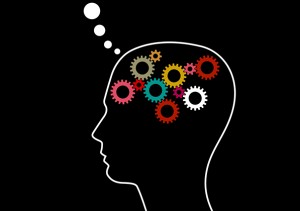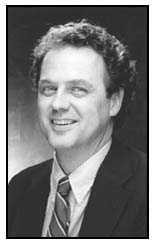
“Does mind exist?” asks neuroscientist Daniel Siegel, as he opens a two-day conference on his favorite subject, interpersonal neurobiology. Siegel is on a mission to tell the world that by working to make changes in your mind you can reorganize the neural pathways in your brain. He insists that if you work at it, you can spend more time in “Beginner’s Mind” and improve your personal relationships. Unsatisfied by the old scientific definition that the mind is what the brain does, he says that “such a view essentially reduces the mind to an MRI.” As he sketches an upside-down triangle with mind and brain at the top two corners and relationships at the lower vertex, he explains that “The mind is an embodied and relational process that regulates the flow of energy and information. There are two worlds—that of physical reality, and that of mindsight.” Siegel defines mindsight as “our human capacity to perceive the mind of the self and others. It is a powerful lens through which we can understand our inner lives with more clarity, integrate the brain, and enhance our relationships with others.”
So if the mind is that upside down triangle, what’s the brain? Or, as Siegel prefers to call it, “the embodied brain.” At its most basic level, he says, the brain is a nest of neurons in the head that connect our anatomy with our functioning, with ten to the millionth power of firings taking place all the time. Since our prior experiences have shaped our own personal neural firing intensity, how we process them is key to our wellbeing. We can process the information and impressions that come at us in two ways: by either top-down or bottom-up strategies.
Wikipedia’s definition for the top-down approach is that it “starts with the big picture. It breaks down from there into smaller segments…Each subsystem is then refined … until the entire specification is reduced to base elements.” Bottom-up information processing works in the opposite way, “based on incoming data from the environment to form a perception…This strategy often resembles a “seed” model whereby the beginnings are small but eventually grow in complexity and completeness.”
The example Siegel gives of top-down processing is a red light, which controls traffic but at the same time restricts it. He invites those present to visualize how we process whatever comes at us with internal green, yellow, and red lights. Top-down thinking is neither bad nor good, he adds, and very useful when it helps organize one’s life. But it can become a prison when there is too much restriction. As for bottom-up processing, he calls it “Beginner’s Mind.” “Hmm,” I mutter to myself as I rest for a moment from compulsive note-taking. “What internal red lights prevent me from being open and free to move in any direction? And when do I operate from Beginner’s Mind?”

Siegel himself has a highly educated Beginner’s Mind as he fields questions from the stage, seeking continually to rephrase and reform his thoughts off the cuff in his responses. He began with a degree in biochemistry, then went on to medicine, to pediatrics, to psychiatry, and finally to his own corner of neuroscience, which focuses on how relationships shape and reshape the brain. (See Parabola Summer 2011, “The Neurobiology of We.”) He now travels all over the world telling everyone, including the king of Thailand, Pope John Paul II, and His Holiness the Dalai Lama, how the mind can change the brain. His many books include Mindsight: The New Science of Personal Transformation, in which he details how relationships and the brain interact to shape who we are, and The Mindful Brain, which Buddhist teacher Jack Kornfield calls “a brilliant and visionary wedding of mindfulness and neurobiology.”
But if what he says is true, I wonder, then why aren’t we different, improved, and always at our best? As if reading my mind, he explains that “the brain can change states very fast, but the body can’t keep up with it. However, the body keeps the score.” We could learn a lot from animals, he adds, because their reactions dissipate quickly, rather than festering and making them ill, as sometimes happens with us. A dog who slinks away ashamedly after a scolding soon returns wagging its tail, free of guilt or resentment, ready for whatever’s next.
As Siegel links the moods and states that flow through us all day long to anatomical changes in the brain, he points out that presence — which he defines as attunement, resonance, and trust —increases telomerase, improves epigenetic regulation, and enhances immune functions, all very important in relationships. Although “any word for it is a top-down concept,” he adds, “pre-sense opens up our nervous system to be really here. Presence is the portal for integration and integration is the natural outcome of complex systems and improves natural healing. In other words, presence improves both relationality and enzymes, and integration is the linkage of differentiated parts.”
In his psychiatric practice Siegel aims for development through secure attachment, mindfulness meditation, and effective psychotherapy, explaining that they impact a similar neural mechanism that is proven to promote wellbeing. “Imagine immersing yourself in a systematic exploration of the nature of mind that gives you a new way to experience life,” he writes in a recent blog on his website, drdansiegel.com. “And then consider that you can ‘integrate consciousness’ at the same time as you are diving deeply into a new way to know your mental world…Every form of change seems to require consciousness: education, parenting, personal growth, psychotherapy. Each of these ways we help others, or ourselves, to grow and change, to develop in a focused way; each calls for the growing individual to be aware, to be conscious…Well-being seems to arise from a fundamental process of integration.”
Most of us would agree that our tendency to react and hold onto our reactions can make us unhappy and interfere with relationships with others as well as with our own body-brain, but it’s not so obvious that letting our minds wander from here to Timbuktu and back can also affect our mood. In a recent study by Matthew Killingsworth and Daniel Gilbert (1), more than two-thousand adults were asked whether their minds wandered during their day-to-day activities. It turns out that forty-seven percent of the time their minds were not focused on what they were doing. Even more striking, they reported that they were less happy when their minds were wandering.

Other approaches to retraining the brain include neurofeedback. Studies show it may help alleviate anxiety, depression, chronic pain, attention-deficit disorder, autism, and other neurological conditions. Neurofeedback is of special interest because it represents another approach to drugs for people with learning disabilities like ADD, ADHD, anxiety, depression, or other forms of brain imbalance. While the positive effects of drugs disappear as soon as they leave the bloodstream, pioneer neurotherapist Stephen Larsen points out in his latest book, The Neurofeedback Solution: “We now find that when the brain is put in touch with itself (the elemental principle of biofeedback), miraculous things begin to happen. Among other things, it is eminently capable of modifying itself without chemicals or other mechanical help. Aberrations such as depression and anxiety are not ‘things’ (symptoms) to be ‘eliminated’ but suboptimal conditions of the nervous system when it isn’t working so well. When functionality is restored, and the system begins intelligently to self-regulate, the ‘symptoms’ drop away by themselves.” (2)
Sensitive instruments are used in various neurofeedback systems to record and track brainwave signals. These patterns are amplified and displayed on a computer in discrete frequency bandwidths, measured in cycles per second, or Hz — from slow delta waves, as in a sleeping state, through slow-medium theta to medium or neutral alpha, to fast beta waves. Each frequency waveform can be seen in context as well regulated or dysregulated — over or under-aroused. According to Larsen, delta waves may indicate a type of depression; alpha waves an obsession; beta waves an active focus or high anxiety; and theta waves may signify EEG slowing and ADD, but are also associated with states of creative inspiration, connecting the conscious with the unconscious, and mystical experience.
Traditional neurofeedback methods usually involve sensors placed on the scalp to measure brainwave or cerebral blood-flow activity, which appears as a video on a screen or gives off sound so the patient can receive real-time information about what’s going on in the brain. Gradually he or she learns to self-regulate, increasing the activity and flexibility of brain functioning. For example, audio-visual stimulation may include wearing glasses with flashing lights, or earphones that emit sound vibration in different frequencies from delta to alpha and beta waves. These frequencies “speak” to similar frequencies in the patient’s brain as he or she learns which are desirable and which are not. In ADHD and ADD there are often too many slow theta brainwaves (associated with daydreaming) and not enough beta waves (associated with mental focus). In such cases, neurofeedback therapies might aim at increasing the production of beta waves and decreasing theta waves as the patient watches his or her own brainwave levels on a screen and attempts to change them.

I spoke with neuropsychologist James Lawrence Thomas, author of Do You Have Attention Deficit Disorder? whose Brain Clinic (www.thebrainclinic.com) specializes in diagnosing and treating adult ADD, learning disabilities, mild head injuries, bipolar disorder, depression, and pain management. Treatment can include psychotherapy, cognitive remediation, neurofeedback, and biofeedback. He explained that the term neurotherapy includes all forms of training the brain with special equipment while neurofeedback usually refers to brainwave training, also called EEG Biofeedback. Since brain waves occur in various frequencies from slowest (delta) to fastest (gamma), experts have uncovered typical patterns in a variety of illnesses such as ADD, dementia, traumatic brain injury, and obsessive-compulsive disorders. An expert with specialized equipment is able to measure your physiology in several ways and feed this information back to you on a computer screen. You watch the measurements of your heart rate variability, muscle tension, or brain waves on a screen as you learn how to control them. Those with cardiac problems can be trained to control heart-rate variations, while those with headaches, hypertension, anxiety, or tinnitus attempt to control their temperature or their brain waves.
I observed a session with Dr. Thomas in hemoencephalography, a biofeedback method that trains you to monitor and increase cerebral blood flow in the prefrontal cortex—seat of executive functions like planning, judgment, organization, and inhibition. An infrared camera on your forehead reads cerebral blood flow while you watch a movie you have chosen from a large stack of DVDs. If the frontal lobe blood flow and temperature remain high, the movie continues, but if the temperature drops, the movie stops. Then you must focus on a bar graph display to increase cortical activity so that the film can begin again.
Thomas’s recent article on Brain Brightening (3) makes a case for neurotherapy for seniors or others who feel a decline in alertness and memory. It is a process in which the arousal level of the brain is raised by targeting exact areas of the brain to decrease the slower brainwave activity while increasing activity associated with focus and concentration, so the person feels more energized and alert. Thomas points out that many elderly people suffer cognitive decline due to frontal lobe atrophy, and that those with mild decline can be helped by biofeedback technology to train themselves to become more aware of, and even learn to control, their temperature, blood flow or brain waves.
Another form of neurofeedback is the LENS or Low Energy Neurofeedback System, which uses a faint electromagnetic field smaller than that of a digital watch to carry a tiny feedback stimulus to the brain of its own brainwaves in order to restore optimal brain function. Lasting less than a second, this feedback signal mirrors, but slightly differs from, the patient’s own dominant frequency. This slight change, or offset from the EEG software, sets up a brief fluctuation in brainwave patterns, allowing dysfunctional ones to correct themselves. In other words, through disentrainment, the brain is helped to release habitually “stuck” brainwave patterns or neural “roadblocks” resulting from past trauma, prolonged stress, and other difficulties.
The LENS differs from traditional neurofeedback, in which the patient looks at a screen and is “rewarded” or “punished” by paying attention to the animation or losing focus. While LENS uses the standard electrode placement of nineteen to twenty-one sites on the head, it is a passive, “whole-being approach” according to neurotherapist Anton Bluman (see www.ADrugFreeAlternative.com). As he puts it, “You close your eyes and get out of your own way rather than try for results. The more neutral your state the better, allowing self-correction to occur beneath the conscious mind.”

Bluman has spent more than thirty years in mind-body awareness training and related East-West disciplines, and twenty years working with the neurologically impaired. He told me that our body and nervous system are always at work trying to heal us and restore equilibrium, and that with sufficient training, functionality can be restored. “The brain is a receiving apparatus that can change its neuronal circuitry through experience,” he explained. “The LENS hardware analyses the EEG data for the therapist, who looks for certain recognizable dysfunctional patterns and chooses a customized protocol accordingly. Then the software facilitates the ‘self-correcting.’”
I undertook a session with Bluman at his office in Tarrytown, New York. After I filled out a questionnaire on my main issues and we discussed them, Bluman placed a sensor on each earlobe and another on different sites on the left and right sides of my head, one by one. The aim wasn’t to focus on each site so much as to bring the whole brain to working more efficiently.
After ten or fifteen minutes I definitely felt quieter and more relaxed, secretly hoping that my executive function was improving by leaps and bounds as well. Were I a regular patient, I would probably have six to twelve sessions to deepen the experience. Says Bluman, “My aim as a therapist is to help the patient find calm, resilience and flexibility by developing the ability to manage life’s stressors and come back into balance more easily. It’s a shift from reactivity to increased sensitivity. I also think of it as cultivating Quiet Mind. If there’s too much noise in the nervous system, by smoothing out volatility in the brainwaves the patient can develop clarity, emotional control, and the ability to organize and respond better to the environment.”
Both interpersonal neurobiology and neurotherapy are on their way to become important branches of the science of the future. Even a cursory glance at the new brain science, with its use of functional magnetic resonance imaging (fMRI) feedback to see what’s going on in our brains in real time, illustrates how good or bad habits build up neural pathways, which can grow in size from a footpath to a highway when repeated hundreds of times a day. But not all of us who want to exchange our bad habits for good ones need a neurotherapist. The best bottom-up approach I know of is the Alexander Technique, a form of neuromuscular re-education that invites us to return to the coordination and freedom we felt as small children, before our parents told us endlessly to sit up straight, our teachers insisted we stay in our chairs all day, or various physical accidents, ailments, and emotional events created fixed habits of tension.
The Alexander Technique focuses on the stress and chronic pain caused by habitual misuse of the body. It can bring relief to those who suffer from poor posture, spine and joint pain, headache, tendonitis, carpal tunnel syndrome, and frozen shoulder, as well as people with Fibromyalgia, Parkinson’s, MS, osteoarthritis, and other disorders of the musculo-skeletal system. Musicians, actors, singers and dancers also use the Technique to perfect their performance. How it works: At the beginning you need the help of a teacher’s hands to learn how to recognize and release unconscious habits of excess tension and undertake practical exercises to develop or restore a more balanced posture and coordination.

Like many discoveries, F. M. Alexander’s method began with self-study. He suffered from chronic hoarseness that threatened his acting career until he saw how unconscious habits were causing his poor posture, faulty breathing, and excessive strain. Eventually he learned how to consciously prevent them and began to teach his technique to others in the early twentieth century. His classic question: “How did you use yourself today?” strikes a deep chord, along with his statement, “My work is the study of human reaction.”
Another brilliant twentieth century mind/body innovator is Moshes Feldenkrais, who developed his teaching out of a study of his own injuries from playing soccer. An Israeli scientist and Judo master, he helped himself by applying his knowledge of physics and engineering to body–brain mechanics, and went on to teach Functional Integration. His followers also teach group classes called Awareness through Movement. Like Alexander, Feldenkrais insisted on calling himself a teacher rather than a therapist because he taught something to his students that they could then utilize for themselves. His statement in his book The Potent Self applies equally to the new brain science and to all of us, no matter what our difficulties: “Movement is life. Life is a process. Improve the quality of the process and you improve the quality of life itself.”♦
ENDNOTES
1. Killingsworth, Matt Does Mind-Wandering Make You Unhappy? Article on The Greater Good Science Center website, University of California at Berkeley, 7/16/2013
2. Larsen, Stephen, The Neurofeedback Solution, Healing Arts Press, Rochester, VT 2012, page 37.
3. Thomas, chapter entitled Brain Brightening: Neurotherapy for Enhancing Cognition in the Elderly in the book Enhancing Cognitive Fitness In Adults, A Guide to the Use and Development of Community-Based Programs, edited by Paula Hartman-Stein and Asenath Larue, Springer, New York 2011
